leadr.msu.edu | @leadr_msu

- Collaborative space for students to build digital projects and explore digital techniques
- Equipment, software, & general support for projects
- Open & staffed 10am-8pm Mon-Thu, 10am-5pm Fri

What is Digital Humanities?

http://dlaf14.qwriting.qc.cuny.edu/2014/09/04/digital-humanities-bringing-society-together/
Five Categories of Digital Humanities
- humanistic scholarship presented in digital form(s)
-
humanistic scholarship enabled by digital methods & tools
-
humanistic scholarship about digital technology & culture
-
humanistic scholarship building and experimenting with digital technology
-
humanistic scholarship critical of its own digital-ness
Josh Honn, “Never Neutral: Critical Approaches to Digital Tools & Culture in the Humanities.”
What is Digital History?

http://www.philipvickersfithian.com/2011/10/why-are-there-23-digital-history.html
Digital History is Immersive
To do digital history...is to create a framework, an ontology, through the technology for people to experience, read, and follow an argument about a historical problem.
Digital history possesses a crucial set of common components—the capacity for play, manipulation, participation, and investigation by the reader...[The reader] can test the interpretations of others, formulate new views, and mine the materials of the past for overlooked items and clues. The reader can immerse him/herself in the past, surrounded with the evidence, and make new associations. The goal of digital history might be to build environments that pull readers in less by the force of a linear argument than by the experience of total immersion and the curiosity to build connections.
-WIlliam G. Thomas III (2008)
Interchange: The Promise of Digital History - Journal of American History
Digital History is Visual
The digital medium is a visual one and has already helped us see the past in ways that were difficult to do before. This has happened on several levels. There’s the ability to access images and video with new efficiency and therefore to make these forms a more central part of historical analysis. There are the possibilities for mapping: the plotting of data though gis maps to see the spatial dimensions of people’s lives or capturing movement through animated maps. Even databases have helped us to see social networks, such as families and communities, with new clarity.
-Amy Murrell Taylor (2008)
Interchange: The Promise of Digital History - Journal of American History
Digital History is Public History
Digital history is a kind of public history: when we put materials online, we enter into a conversation with individuals from all walks of life, with various voices and degrees of professionalism...
Edward L. Ayers has argued that, while a “democratization of history” has taken place since the emergence of new historical fields in academia, a “democratization of audience” has yet to come.
-Shawn Graham, Guy Massie, and Nadine Feuerherm (2013)
"The HeritageCrowd Project: A Case Study in Crowdsourcing Public History" in Writing History in the Digital Age
(in theory)
Digital History is Collaborative

-Scott Weingart "Submissions to Digital Humanities 2015 (pt 1)" [scottbot.net]
This second stage will require interdisciplinary collaboration, the likes of which most historians have yet to embrace; cooperative initiatives that involve historians, programmers, information architects, designers, and publishers. Libraries are already creating the infrastructure to collect, manage, explore, and manipulate these sources and to support and sustain the various forms of “new-model scholarship” that might come out of them...
-Seefeldt & Thomas "What is Digital History? (2009)
Digital History Enhances Traditional Methods
[D]igital capacities enhance research with all kinds of sources and scales. GIS and various forms of visualizations and other analytic representations or manipulations can be, and have been, as liberatingly innovative in dealing with bounded, proximate data as they are with unbounded and globally distributed datasets. New tools for engaging oral history sources in their primary media illustrate the point: some of the smaller-scale engagements unfolding new capacities for dealing seriously as historians with the orality, performance, and embodiment in these documents have been more productive, instructive, and exciting than the imperfect uses to which very large collections of digital audio and video interviews have been put.
-Michael Frisch (2008)
Interchange: The Promise of Digital History - Journal of American History
Digital History Challenges Traditional Methods
Digital history and the abundance it tries to address make many historical arguments seem anecdotal rather than comprehensive. Hypotheses based on a limited number of examples, as many dissertations and books still are, seem flimsier when you can scan millions of books at Google to find counterexamples. I believe it will be possible to marry digital techniques with close reading and traditional methods, but very soon it will be perilous to ignore these new techniques.
-Dan Cohen (2008)
Interchange: The Promise of Digital History - Journal of American History
Examples of Digital History

From: http://creatingdigitalhistory.wikidot.com/
Historical Social Networks
Kindred Britain is a network of nearly 30,000 individuals — many of them iconic figures in British culture — connected through family relationships of blood, marriage, or affiliation. It is a vision of the nation’s history as a giant family affair.

Kindred Britain | http://kindred.stanford.edu/
Large databases
Slave Biographies | slavebiographies.org

Slave Biographies: The Atlantic Database Network is an open access data repository of information on the identities of enslaved people in the Atlantic World. It includes the names, ethnicities, skills, occupations, and illnesses of individual slaves. Users can access data about slaves in colonial Louisiana and Maranhão, Brazil and download datasets, search for ancestors, and run statistical analysis.
Distant Reading of Archival Texts
Quantifying Kissinger | quantifyingkissinger.com

As larger and larger archives of human cultural output are accumulated, historians are beginning to employ other tools & methods...to overcome ‘information overload’ and facilitate new historical interpretations. This project is an application of ‘big data’ computational text analysis techniques to research...approximately 17500 meeting memoranda (‘memcons’) & teleconference transcripts (‘telcons’) detailing Kissinger’s correspondence during the period 1969-1977: it is a first effort at ‘Diplonomics’.
Topic Modeling of Archival Documents
Mining the Dispatch | dsl.richmond.edu/dispatch

This project, "Mining the Dispatch," seeks to explore—and encourage exploration of—the dramatic and often traumatic changes as well as the sometimes surprising continuities in the social and political life of Civil War Richmond. It uses as its evidence nearly the full run of the Richmond Daily Dispatch from the eve of Lincoln's election in November 1860 through...December 1865, an archive of over 112,000 pieces consisting of nearly 24 million words.
Reimagining Historical Sources
Queering Slavery Working Group | qswg.tumblr.com/

QSWG was formed to discuss issues related...histories of intimacy, sex, and sexuality during the period of Atlantic slavery. Guided by the question, “What would it mean to Queer Slavery?,” the group seeks out queer encounters in slavery’s archive...QSWG brings discussions happening in black queer studies, queer of color studies, and histories of enslaved and free people of African descent across the diaspora into lurid and profane contact..."You cannot find in the archive what you cannot imagine."
Historical Making
Kits for Culture | maker.uvic.ca/kch/

The primary aim of the project is to express the histories of media, technologies, and science through new media, especially physical computing and digital fabrication techniques...Physical kits “remake” old technologies and media that have been largely ignored, no longer exist, or are difficult to access. Rather than communicating humanities research solely in a written format, these open-source kits encourage hands-on, exploratory engagements that playfully resist instrumentalism as well as determinism.
"The Spatial Turn"
Beyond the academy, GIS opened questions of vertigo-inspiring scale. By scraping spatial data from archives of unprecedented vastness, researchers stood a better chance than ever before of addressing problems of tremendous size...
The spatial turn represents the impulse to position these new tools against old questions...We remember that every discipline in the humanities and social sciences has been stamped with the imprint of spatial questions about nations and their boundaries, states and surveillance, private property, and the perception of landscape, all of which fell into contestation during the nineteenth century.
-Jo Guldi, "What is the Spatial Turn?" http://spatial.scholarslab.org/spatial-turn/
Spatial History
Chronology will always remain at the heart of a discipline that seeks to explain change over time, but this has left historians open to the charge from geographers that they write history as if it took place on the head of a pin. The charge is not true, but sometimes it is uncomfortably close to being true...Historians still routinely write about political change, social change, class relations, gender relations, cultural change as if the spatial dimensions of these issue matter little if at all.
-Richard White, What is Spatial History?
Networks & Human Movement
Conventional maps that represent this world as it appears from space signally fail to capture the severe environmental constraints that governed the flows of people, goods and information...ORBIS allows us to express Roman communication costs in terms of both time and expense. By simulating movement along the principal routes of the Roman road network, the main navigable rivers, and hundreds of sea routes in the Mediterranean, Black Sea and coastal Atlantic, this interactive model reconstructs the duration and financial cost of travel in antiquity.

Orbis | orbis.stanford.edu/
Urban Spatial History
The Digital Harlem website presents information drawn from legal records, newspapers & other archival & published sources, about everyday life in New York City's Harlem neighborhood in 1915-30.

Digital Harlem | digitalharlem.org
Representational Space
In my historical research, I use new media to quickly illustrate concepts that would be difficult to articulate in text alone. I am particularly interested in the ability of 3D reconstructions to show how historical architecture manipulated space & thus recover the experience and meaning of past environments.
Coltrain Portfolio | jamescoltrain.com/digital/schol.html

Archives as Supplements

Valley of the Shadow | valley.lib.virginia.edu
The Valley Project details life in two American communities, one Northern and one Southern, from the time of John Browns's Raid through the era of Reconstruction In the digital archive you may explore thousands of original letters and diaries, newspapers and speeches, census and church records, left by men and women...Giving voice to hundreds of individual people, the Valley Project tells forgotten stories of life during the era of the Civil War.
Interpretive Layers on Archives

Going to the Show | docsouth.unc.edu/gtts/
Going to the Show documents & illuminates the experience of movies & moviegoing in North Carolina...The project situates early moviegoing within the experience of urban life in the state's big cities & small towns. It highlights the ways that race conditioned the experience of moviegoing for all North Carolinians- white, African American, and American Indian...Supporting its documentation of more than 1300 movie venues across 200 communities is a searchable archive of thousands of contemporaneous artifacts: newspaper ads and articles, photographs, postcards, city directories, and 150 original architectural drawings.
Crowdsourced Archives

History Harvest | historyharvest.unl.edu
The History Harvest is an open, digital archive of historical artifacts gathered from communities across the United States. The [project] partners with institutions and individuals within highlighted communities to collect, preserve, and share their rich histories. We believe that our collective history is more diverse and multi-faceted than most people give credit for and that most of this history is not found in archives, historical societies, museums or libraries, but rather in the stories that ordinary people have to tell from their own experience and in the things - the objects and artifacts - that people keep and collect to tell the story of their lives.
LEADR Projects
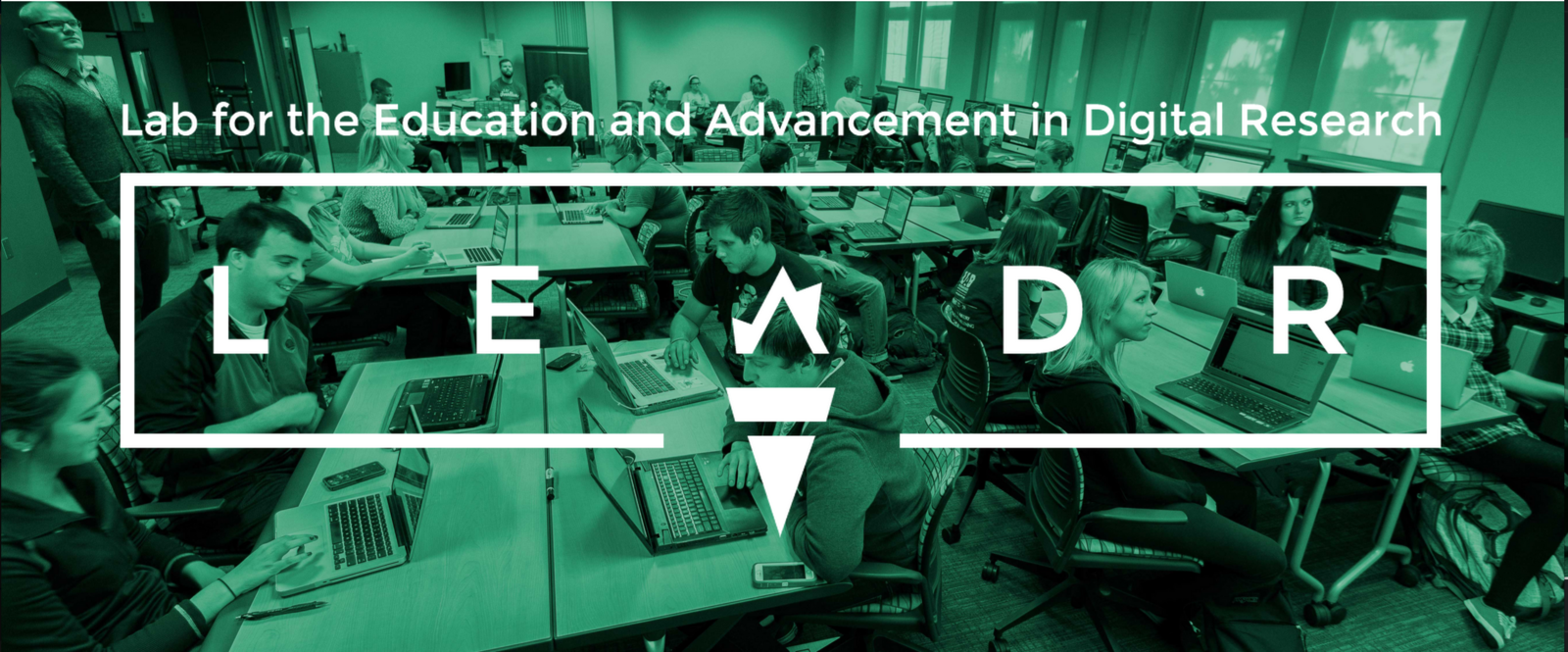
LEADR Projects
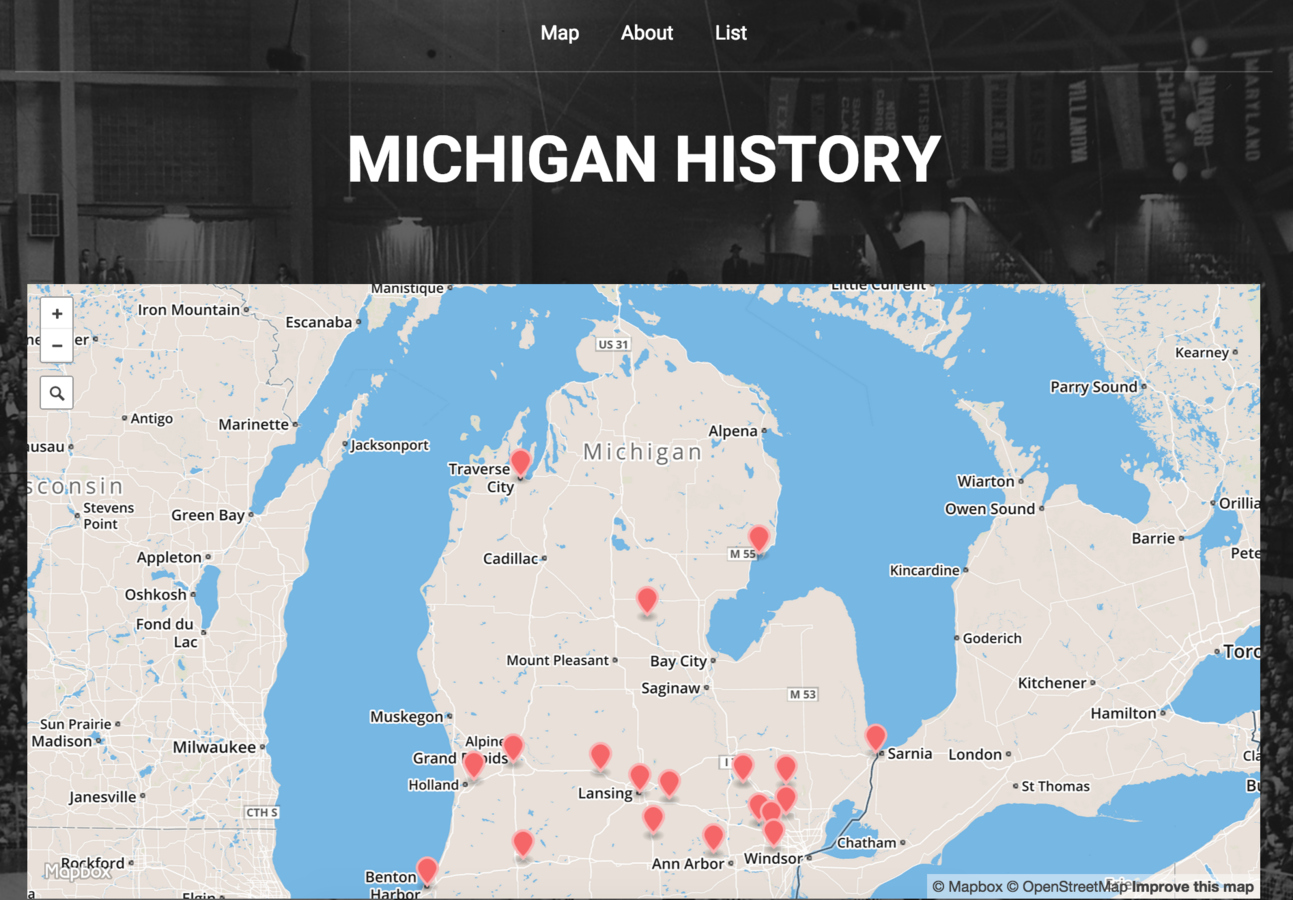
LEADR Projects
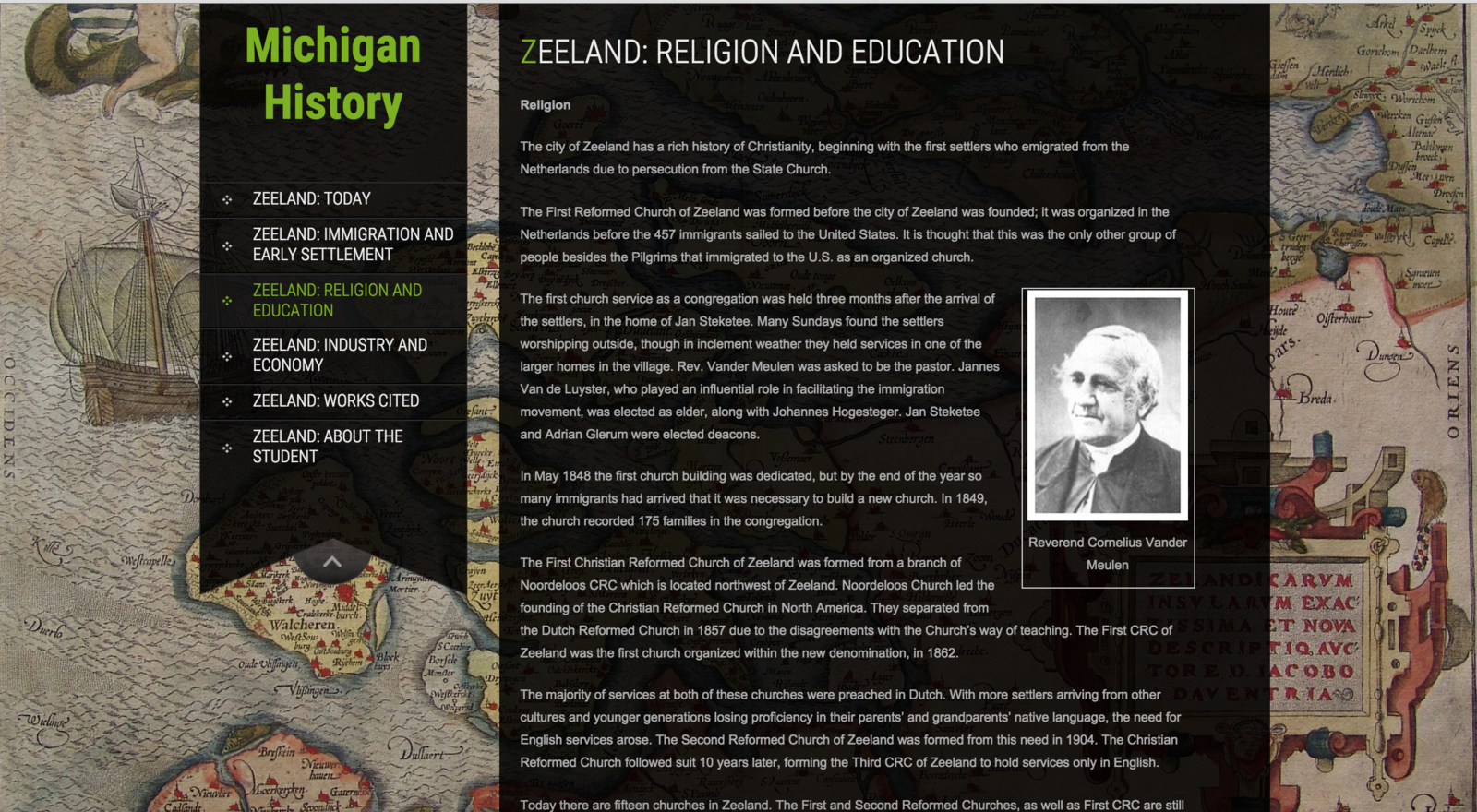
LEADR Projects
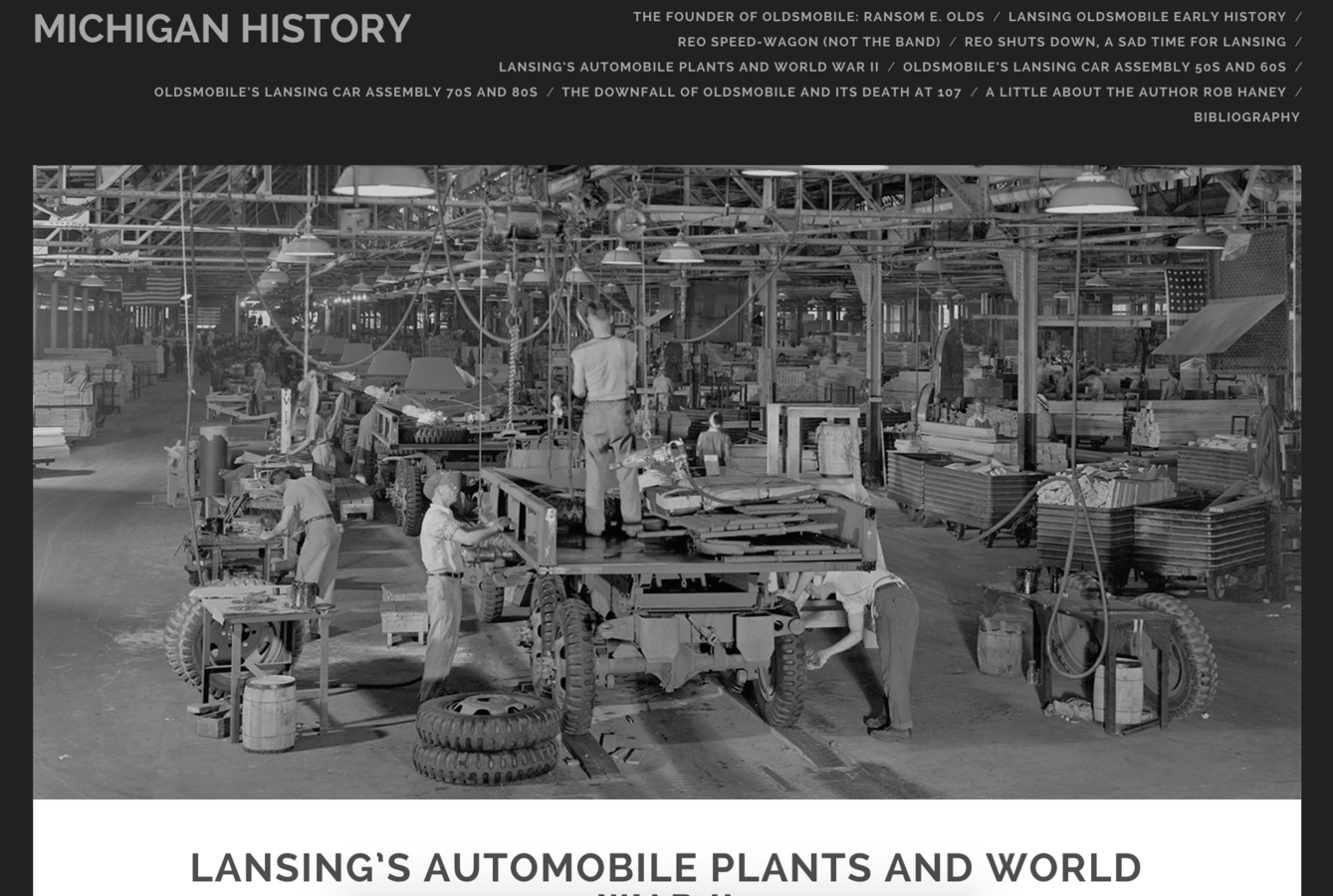
LEADR Projects
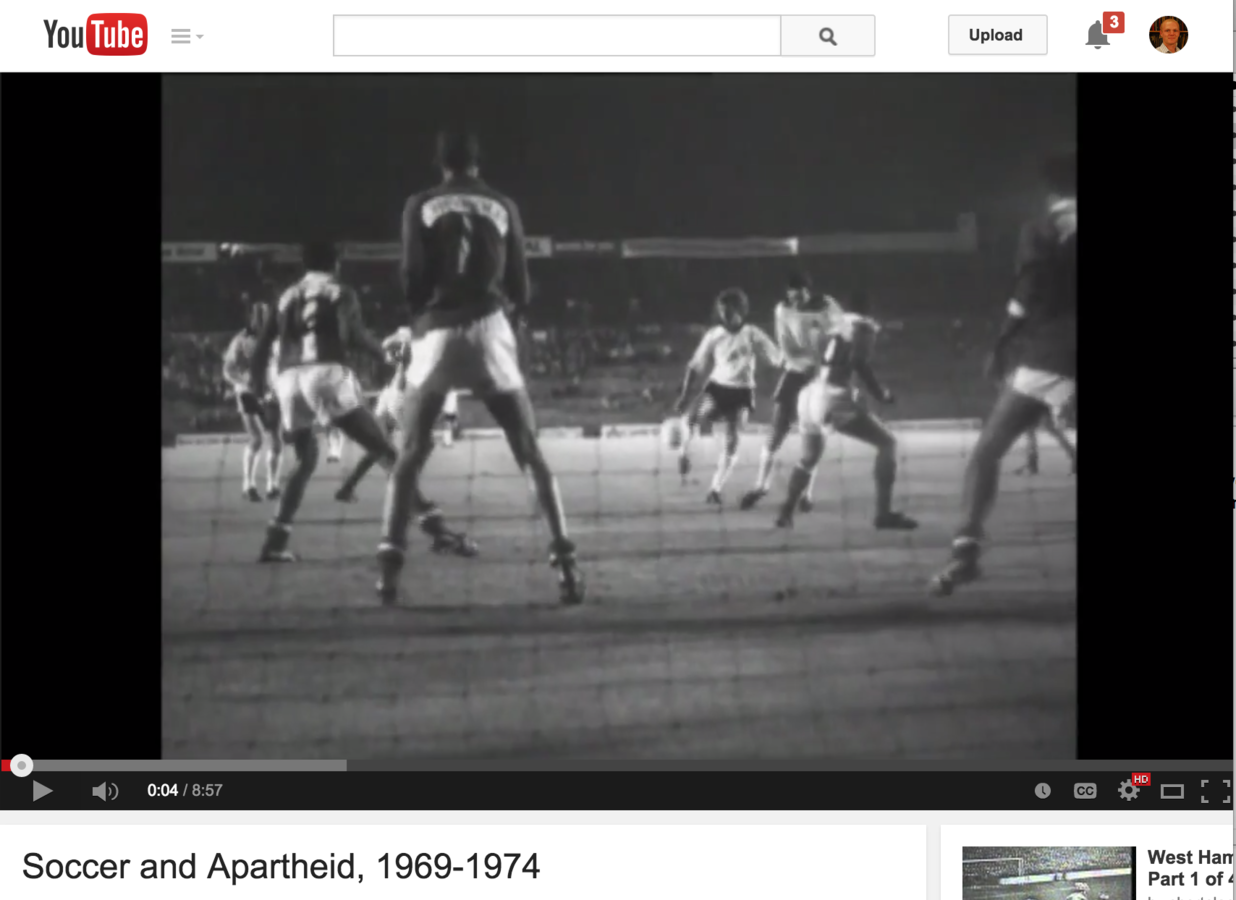
LEADR Projects
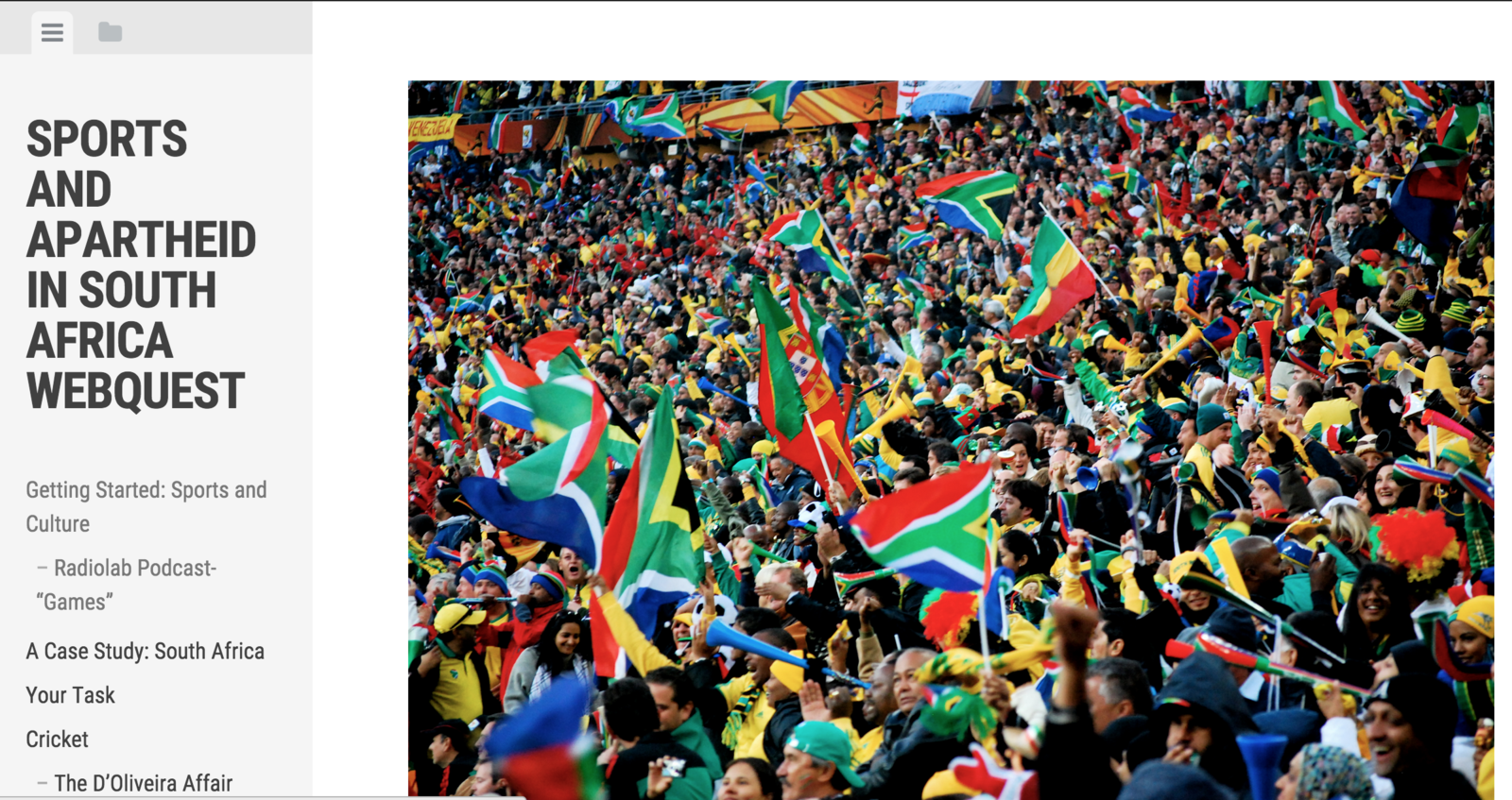
LEADR Projects

LEADR Projects

LEADR Projects
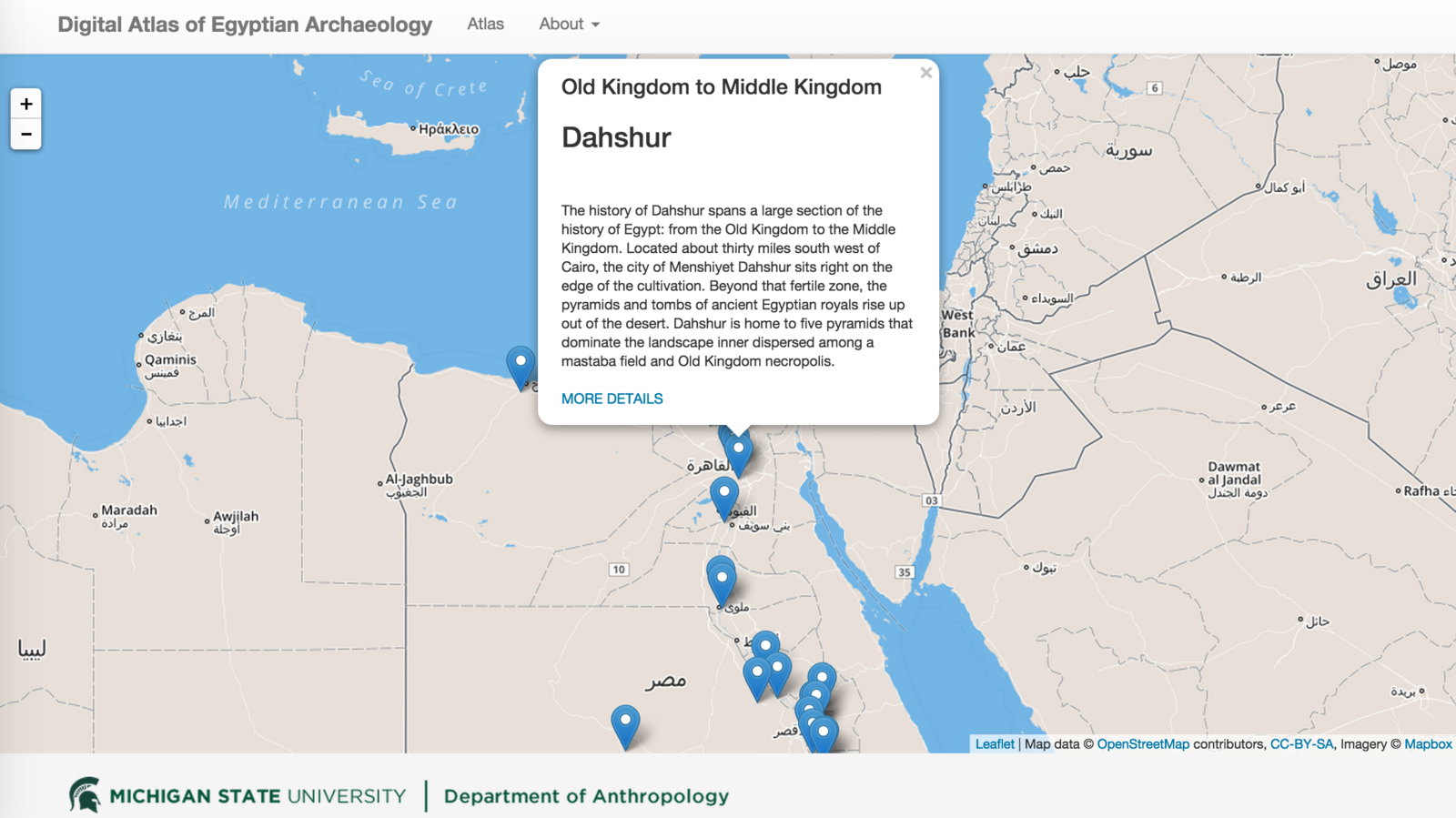
LEADR Projects
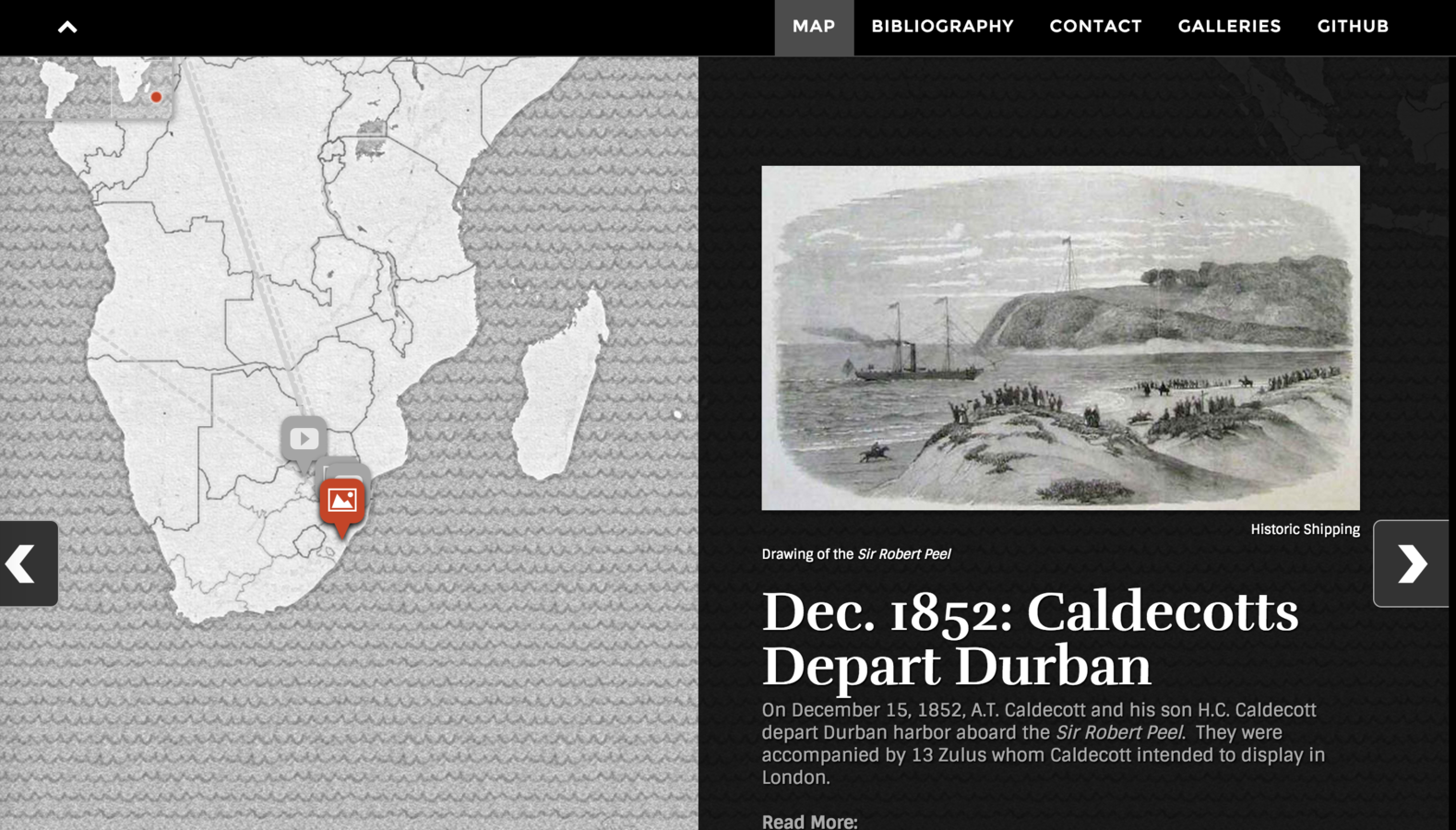
Opportunities in DH at MSU

From: http://annadowling.blogspot.com/
Guidance and Assistance
MSU Libraries
http://www.lib.msu.edu/dh/
Thomas Padilla
Bobby Smiley
Devin Higgins
College of Arts and Letters
http://dh.cal.msu.edu/
Kristen Mapes
LEADR Drop-Ins
10am-8pm M-Th, 10am-5pm F
Liz Timbs
Jorge Felipe Gonzalez
Brian Geyer
Workshop Series
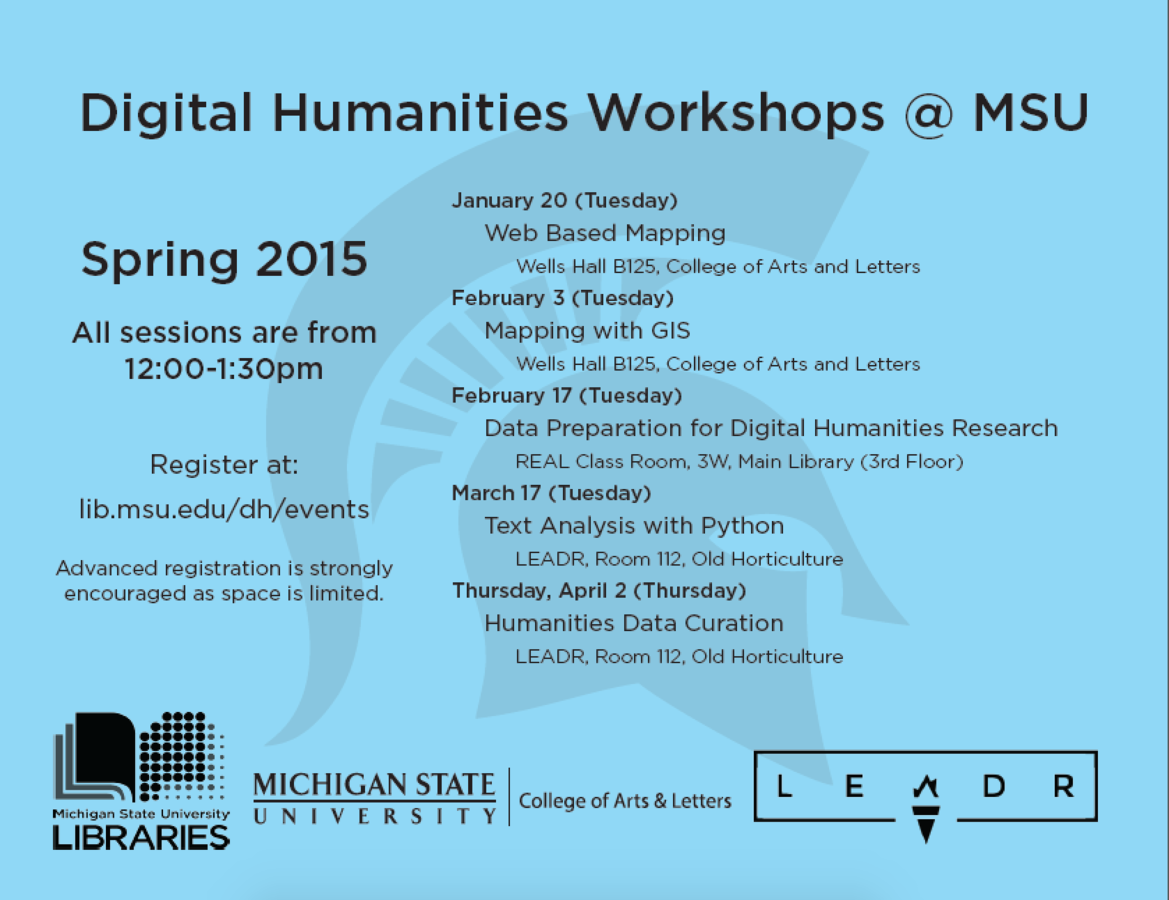
Other Events
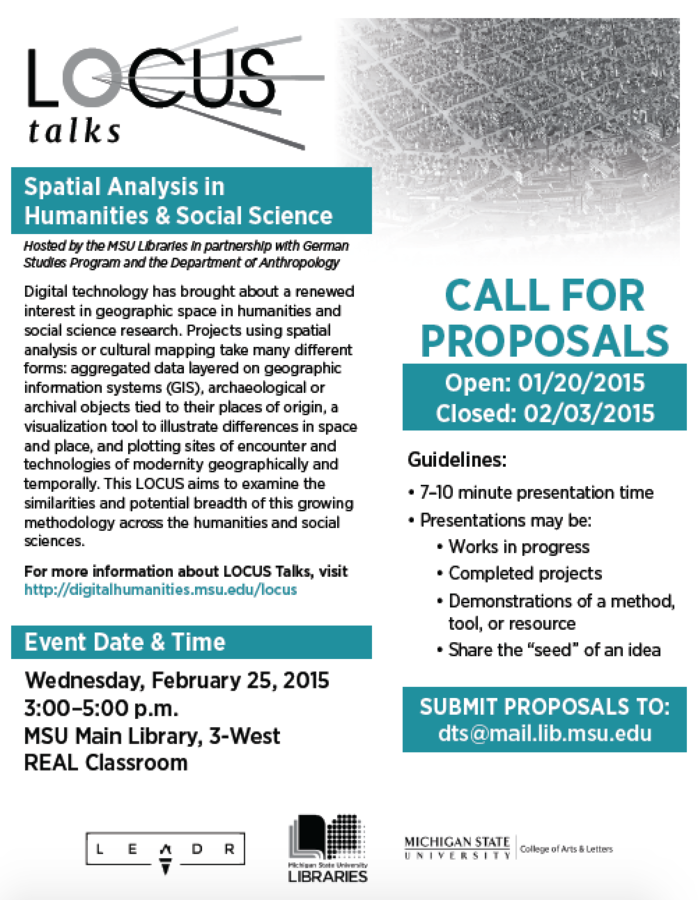
Reading Group
-
January 28 Topic Modeling, led by Sean Pue
-
February 11 Corpus Selection, led by Erin Beard
-
March 25 5-6pm, Dark Side of DH, led by Matt Handelman
-
April 15 12-1pm, DH Feminism, led by Ellen Moll
More information at digitalhumanities.msu.edu
and on the MSUDH listserv
msudh.org/listserv/
Other DH Spaces and Events
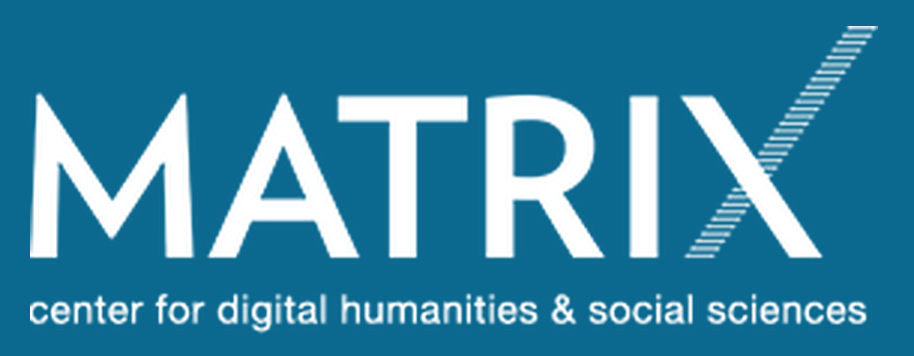



May 27-29, 2015 at MSU
#msudh
Open & staffed 10am-8pm Mon-Thu, 10am-5pm Fri

MSU DH Listserv: msudh.org/listserv/
leadr.msu.edu | @leadr_msu | #msudh
leadr@msu.edu | blocke@msu.edu